
Find the best social media platforms for your marketing in 2023
As the number of social media users continues to rise and marketing options become more sophisticated, excluding social media platforms from a marketing strategy is becoming increasingly difficult. However, despite the numerous opportunities social media marketing presents, the competition is often intense. As a result, you can easily spend a lot of money on advertising on the wrong platform, leading to a low return on investment.
But, there are ways to avoid the pitfalls. In this blog post, we will explore the best social media platforms for marketing in 2023, as well as key factors to consider when determining which platforms will be most effective for your brand.
- Here are the most used platforms for social media marketing globally
- A comparison of the top social media platforms for marketing in 2023
- Overview of platforms for social media marketing
- What are the best social media marketing platforms for businesses?
- Overall perspective on your marketing across social media platforms
Here are the most used platforms for social media marketing globally
Social media platforms come in many variations. In fact, there are over hundreds and hundreds of them. Of course, you're already familiar with the bigger ones, like Instagram, Facebook, and TikTok. There are also many less-known social media platforms. For example, some are relevant based on geographical position, some target a specific topic, and some enable people with similar interests to share their passion.
Depending on your business, some social media platforms are naturally better for marketing purposes than others. In many cases, it’s beneficial to look broad and wide, as well as local and niched. Some platforms offer the possibility to do exactly that and are therefore frequently used by marketers across the globe:
- YouTube
- TikTok
These platforms have a massive user base and offer the opportunity to use sophisticated targeting options for both B2C and B2B. As a result, marketers have the possibility to reach a high amount of people, as well as filter out specific target users.
Even though the bigger ones offer many opportunities, you can also benefit from looking into smaller and more local social media platforms. They can serve an additional purpose if you’re very niched or limited geographically.
A comparison of the top social media platforms for marketing in 2023
Marketing on social media opens up plenty of businesses to reach their ideal audiences, with outcomes such as increased sales, generated leads, higher website traffic, and greater brand awareness. However, each and every social media platform has its pros and cons when it comes to marketing.
When figuring out which channel is the best for your marketing strategy, you need to understand how it’s used. So, let us have a look at the most frequently used social media platforms for marketing in 2023:

Facebook is a powerful tool for connecting with people worldwide, with around 2,958 million users active every month. Facebook allows users to post and share content, such as texts, photos, videos, articles, and much more. There are also extensions, such as Facebook Marketplace, which enable users to list and buy items for sale.
Key Stats:
- Monthly global active users: 2,958 million (Jan 2023) )
- Average time spent per month: 19h 43m (Jan 2023)
- Advertising capabilities: Its advertising capabilities are extensive, providing businesses with the ability to create various types of ads, such as image, video, and carousel ads.
- Targeting capabilities (advertising): Facebook's targeting capabilities allow businesses to create highly targeted campaigns by using a range of options such as age, gender, location, interests, behaviors, and more. Both Facebook and Instagram are part of Meta, which enables you to easily create ad placements for Instagram too.
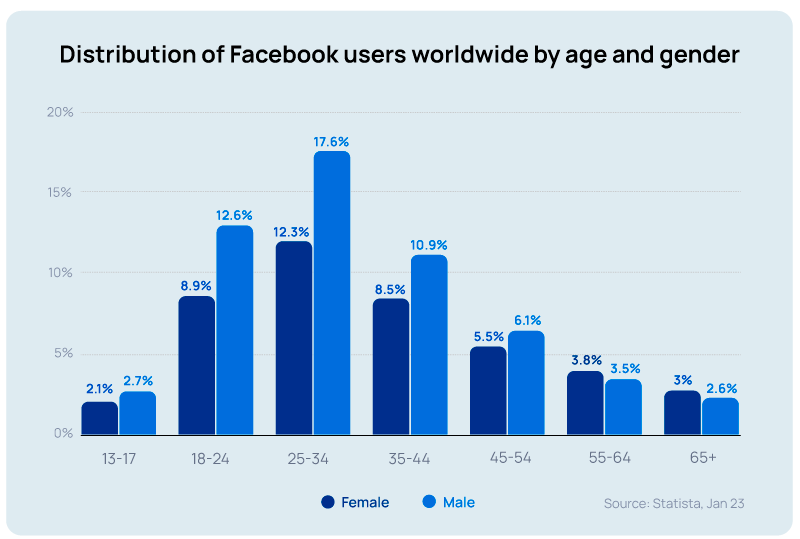 Source: Statista
Source: Statista
- Brands have the potential to reach a large and diverse audience because of the massive user base.
- Facebook has sophisticated targeting features that help brands to tailor ads to specific groups and interests.
- The organic reach for brand pages on Facebook has decreased over time.
- With many businesses competing for attention, it can be challenging for brands to differentiate themselves and attract customers.

Instagram is a highly visual platform, ideal for video and photo sharing. Active users per month are around 2,000 million people, and many use Instagram to seek inspiration, discover trends, and research products and brands. Instagram offers several main features, including a newsfeed, reels, and stories.
Key Stats:
- Monthly global active users: 2,000 million (Jan 2023)
- Average time spent per month: 12h 00m (Jan 2023)
- Advertising capabilities: Its advertising options make it possible to use various elements and formats, such as photo, video, carousels, and stories.
- Targeting capabilities (advertising): Businesses can create highly targeted campaigns by using a range of options such as age, gender, location, interests, behaviors, and more. Additionally, if you create an ad in Ads Manager, there are options to easily create placements for both platforms.
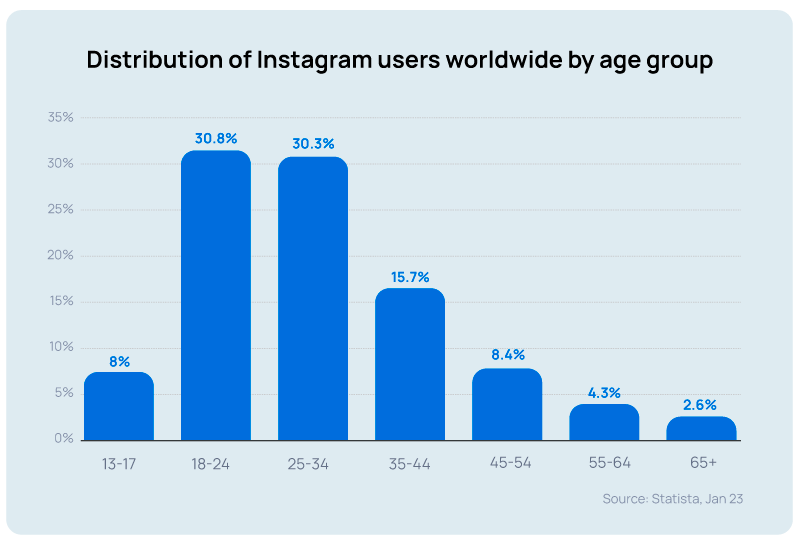 Source: Statista
Source: Statista
- Instagram is great for displaying products and services in a visual way.
- It’s a great platform for reaching new audiences. 83% say Instagram helps them discover new products or services.
- Users are active and engaged.
Cons:
- Instagram has a massive user base, which means that brands face a lot of competition for visibility and engagement.
- Brands need to produce unique and captivating content that catches the eye of users.
- Linking options are limited on Instagram, making it hard to direct users to external sites.
LinkedIn is known as a social media platform for professionals. It's an ideal platform for marketing within B2B and other professional contexts. One appreciated feature among marketers working with LinkedIn is the ability to target organic or paid content by industry, title, company, job search, and more.
Key Stats:
- Monthly global active users: 134.5 million users (2021)
- Average time spent per month: 17 minutes
- Advertising capabilities: LinkedIn's advertising capabilities include sponsored content, sponsored InMail, and display ads in different media formats.
- Targeting capabilities (advertising): LinkedIn's targeting options are tailored to business professionals, allowing businesses to target users based on their job title, company, industry, skills, and more.
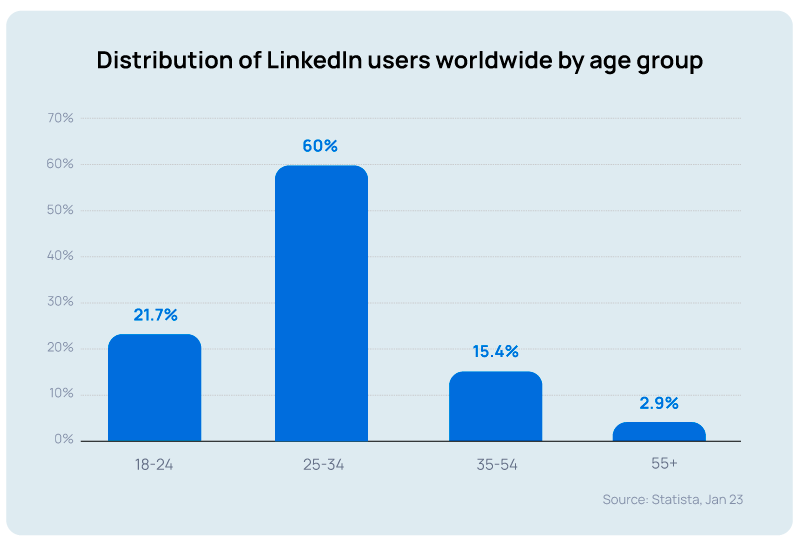 Source: Statista
Source: Statista
- LinkedIn is superior for B2B marketing and professional networking.
- Advanced targeting options for specific industries, job titles, key companies, interests, and more.
- Limited creative options for advertising. For example, you can’t use images and videos on the same campaign.
- LinkedIn’s professional niche comes with a smaller user base.
- Less engagement compared to other social media platforms.

YouTube
YouTube is a massive online video platform with a global reach. It's the world's second most visited website after Google. As many as 2,514 million are monthly active. Some of the most popular videos on the platform are how-to guides and tutorials.
Key Stats:
- Monthly global unique active users: 2,514 million (Jan 2023)
- Average time spent per month: 23h 9m (Jan 2023)
- Advertising capabilities: Offers businesses a range of advertising capabilities, including in-stream ads, video discovery ads, and bumper ads.
- Targeting capabilities (advertising): Businesses can use YouTube's targeting options to reach specific audiences based on demographics, interests, behaviors, and more.
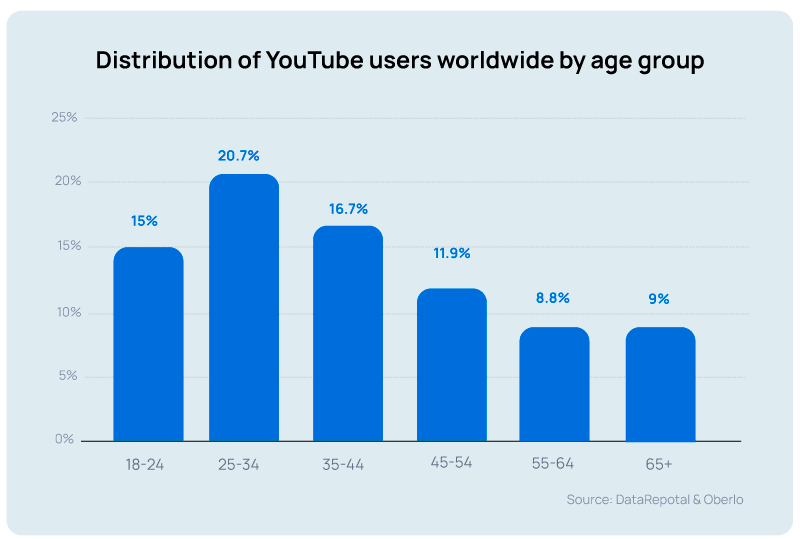
Source: Oberlo
- Video content is highly engaging and shareable.
- Large user base and high search engine visibility can drive significant traffic and brand awareness.
- As the second most visited website, there's high competition for visibility on the platform.
- Video content usually requires significant investment and time, especially for high-quality videos.

TikTok
TikTok is known as the social media platform of Gen Z, with around 1,051 million active users every month. However, its popularity is growing daily, with no indication to be limited to Gen Z. TikTok is a platform where users can post, share, and react to short-video content. Popular content is often quirky and relatable and tends to follow current trends.
Key Stats:
- Monthly global unique active users: 1,051 million (Jan 2023)
- Average time spent per month: 23h 28m (Jan 2023)
- Advertising capabilities: TikTok is optimized for video, but TikTok Ads Manager supports stills as well. There are also many options to create engaging and interactive types of ads and sponsored content.
- Targeting capabilities (advertising): TikTok's targeting capabilities allow businesses to target a specific audience by using a range of options, such as age, gender, location, spending power, behaviors, interests, device, and more.
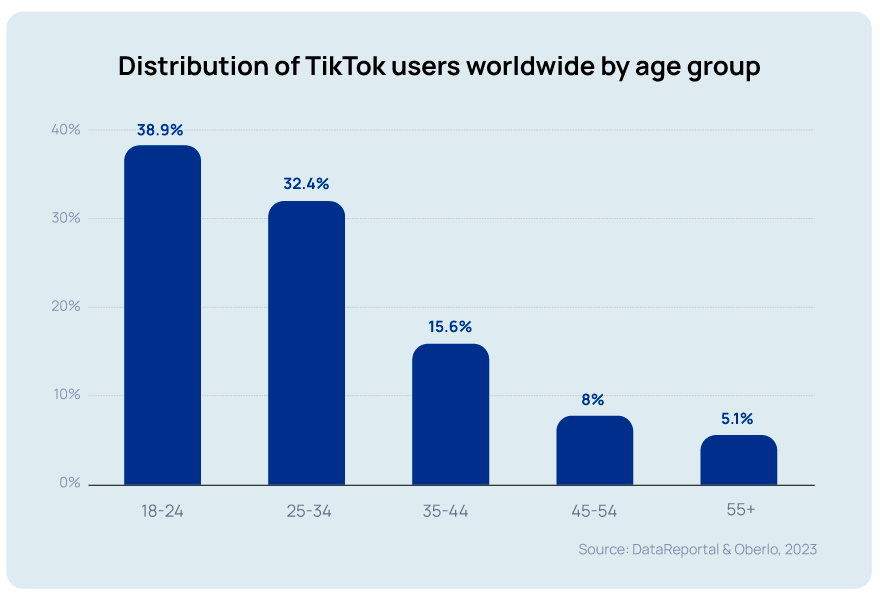 Source: Data Reportal
Source: Data Reportal
Note: TikTok does not provide audience data for users under 18.
Pros:- TikTok is a trending platform with a rapidly growing user base, particularly among younger demographics.
- Opportunities to create high engagement with interactive features.
- There are some limitations in TikTok's content format. Videos are typically short and fast-paced, with a lot of humor, creativity, and authenticity, which may not be suitable for all brands.
- With constantly changing algorithms and many new trends, brands must frequently create new and original video content to keep up.
- Brands must align with the platform's tone and culture to effectively engage with users.

Twitter is a social media platform focusing on short texts of 280 characters or less. Users can also post and share links, polls, images, and videos. There are currently around 556 million active users on a monthly basis. Twitter is a favorite among people working within the news sector.
Key Stats:
- Monthly global unique active users: 556 million (Jan 2023)
- Average time spent per month: 5h 28m (Jan 2023)
- Advertising capabilities: Twitter’s advertising options make it possible to use the original format of 280 characters of text, as well as various other formats, such as photo, video, carousels, and moment ads.
- Targeting capabilities (advertising): Twitter’s targeting capabilities allow businesses to target an audience based on age, gender, location, device, and more. Additionally, you can target by audience type based on conversations, events, interests, keywords, movies, and more.
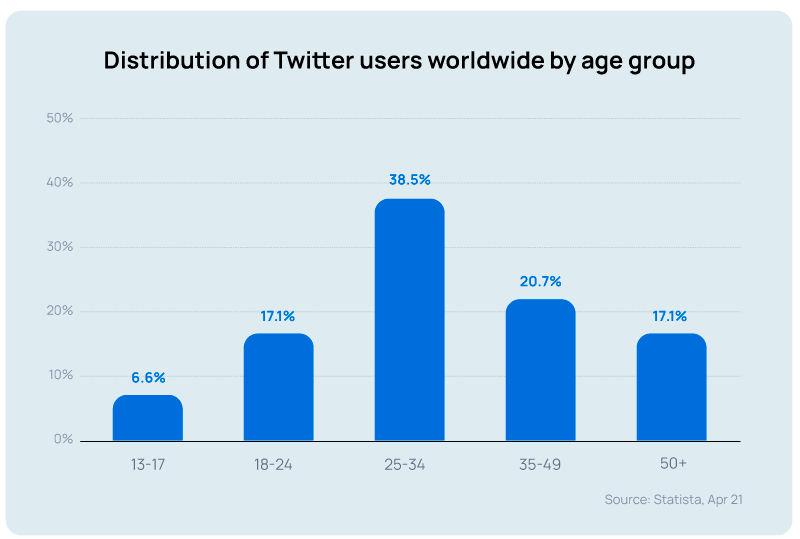
Source: Statista
- Twitter offers great real-time communication and customer service opportunities.
- The platform makes it easy to connect with an audience. You can share valuable content, join ongoing conversations online or run polls to understand people's opinions better.
- The lifetime of a tweet is usually short, requiring brands to post and create marketing content frequently.
- The user base of Twitter is often considered by social media marketers to be niche and limited, compared to other social media platforms. Therefore, your marketing efforts may not have the same reach or impact as other channels.
Overview of platforms for social media marketing
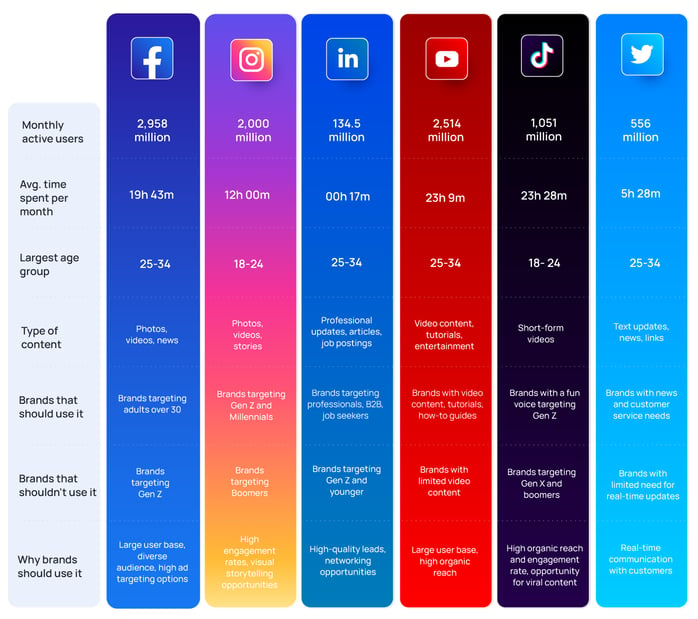
What are the best social media marketing platforms for businesses?
As a rule of thumb, you should only use the social media platform that serves the purpose of your marketing goals. Therefore, the best platform for social media marketing for businesses depends on several factors. Here are some key aspects you could consider when determining which channels serves you the best:
Target audience
By looking at your target audience from an overall perspective, you can understand which platform to use. And notice that it's the overall perspective that is key here. Combining different insights about your target audience lets you see which social media platforms check most of your boxes.
You could, for example, ask yourself:
- Who is your target audience?
- On which platform are your target audiences active?
- What do they use the different platforms for?
- What are their desires, needs, and wants?
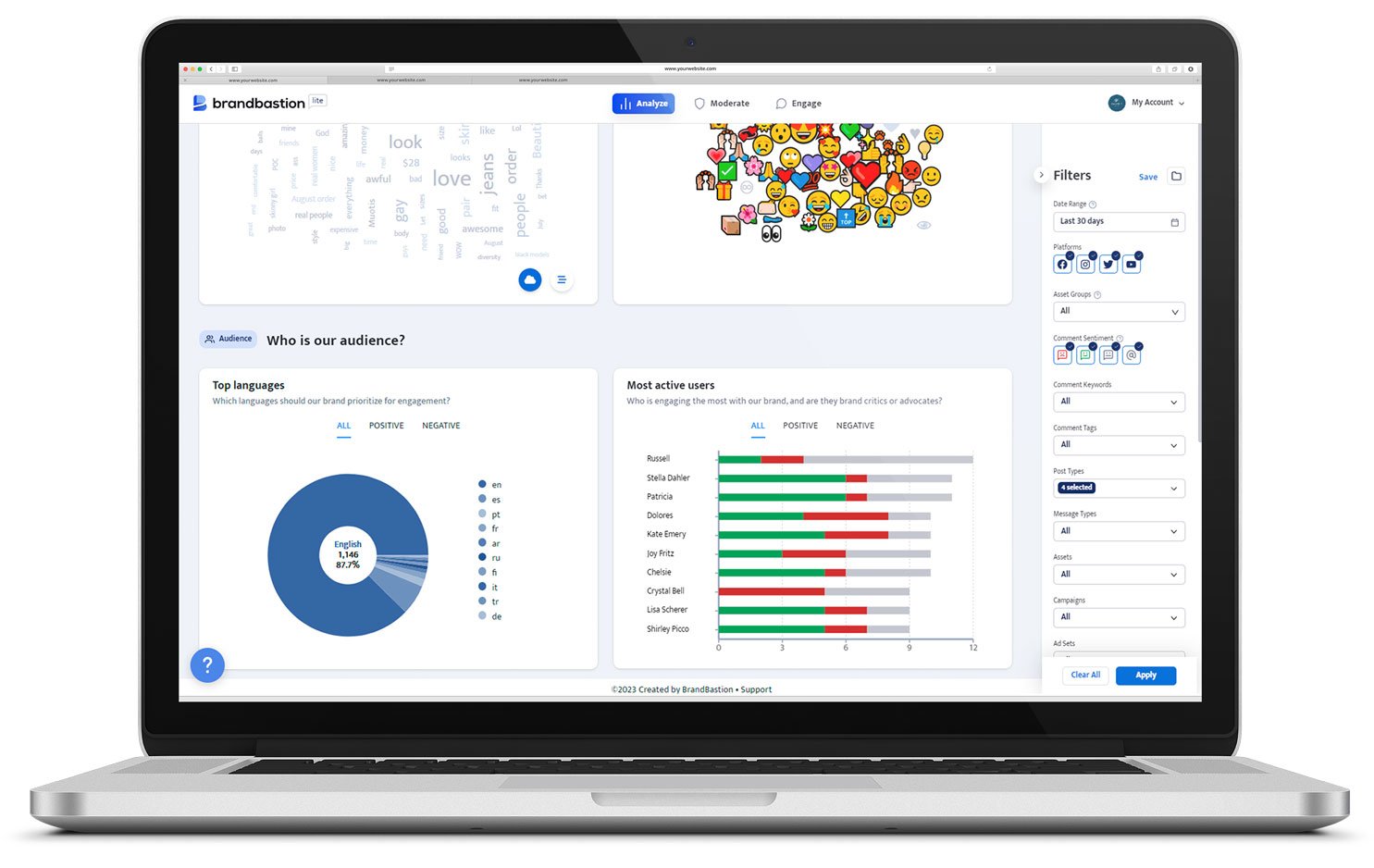
Example of audience insights you can get in BrandBastion Lite
Social media marketing goals across platforms
Each social media platform has its strengths and weaknesses. Different platforms are more effective for specific goals. Here are a few examples of common goals and objectives related to social media marketing efforts:
- Increase brand awareness
- Drive website traffic
- Generate leads
- Boost conversions or sales
- Create positive brand sentiment
- Improve customer service
If you, for example, want to increase brand awareness and boost sales, Instagram could be a good choice. According to a Meta survey, 83% of surveyed say Instagram helps them discover new products or services.
If you, on the other hand, want to generate leads within B2B marketing, LinkedIn is most likely a top choice. It's known as a social media platform for professionals with great potential to generate high-quality leads.
Social media marketing budget and capacity
Advertising costs vary widely between platforms. Before deciding which platform to use, it's essential to have your marketing budget all set up. With the marketing budget as your foundation, it's easier to determine which social media platform gives you the most value for the money.
Then, you can look into the costs of running ads and campaigns across different platforms:
- What are the prices for marketing on each platform?
- What is the average cost for an advertisement on a specific topic or keyword?
In addition, ads, campaigns, and content require internal resources, such as time, competence, and budget. Therefore, it's crucial to evaluate if you're able to meet what's needed to reach your target audience on the chosen platform successfully.
For instance, if you'd like to do marketing on YouTube, you need to create marketing material that meets the platform's content. Since it's a channel with video content, you should consider making advertisements in video format.
Consider the following:
- Do I have the resources to create the marketing material I need for each platform?
- Do I have the budget to produce the material I need to succeed with my marketing efforts on each platform?
Potential and limitations for marketing on each social media platform
Depending on your social media marketing strategy, you can determine which platform has the most significant potential to help you reach a specific goal. It's usually better to choose a few platforms that create real value rather than go with all the platforms. However, sometimes you could benefit a lot from using more than one or two, as long as you know there's actual potential.
Look at the potential of the platform in relation to the goals of your social media marketing efforts:
- Lead generation potential
- Audience reach potential
- Potential to drive traffic to your website
- Potential to build an active social media community
- Possibility to create targeted paid content, ads, and campaigns
In addition, consider what type of advertising showcases your product or service the best. For example, if you're considering sponsored tweets on Twitter, you need to create a short and engaging copy that showcases your intention.
☺️Perfect gift for you or your cool mom!
— Brayou (@Brayoustore) April 27, 2023
👉Shop now: https://t.co/zroc7yEyHc pic.twitter.com/haMtRcSR6A
Example of sponsored ad on Twiter
Competition
Finally, it's important to consider the level of competition on each platform. Some social channels may be more crowded and competitive than others, which could affect the effectiveness and costs of your advertising efforts.
But, if you have a solid social media marketing strategy and use your resources wisely, you could still succeed. It's all about reaching the right people and creating paid social media content that resonates with them.
Overall perspective on your marketing across social media platforms
Consumer behavior changes quickly on social media. Therefore, you must continually analyze the performance across platforms to understand which gives you the most value for money. One of the easiest ways to do this is by using a tool. There are a lot of tools available which provide you with valuable data and insights, such as:
- Insights into which ads and campaigns resonate best with your target audience
- An overview of which campaigns perform the best across platforms
- Facilitate replying to ad comments (using saved replies, autohiding spam, etc.)
- Highlight comments that indicate purchase interests
Would you like to explore some top tools available? Read more about some of the top tools available for social media marketers here. Or, you can jump right into trying BrandBastion's Lite Platform for free!
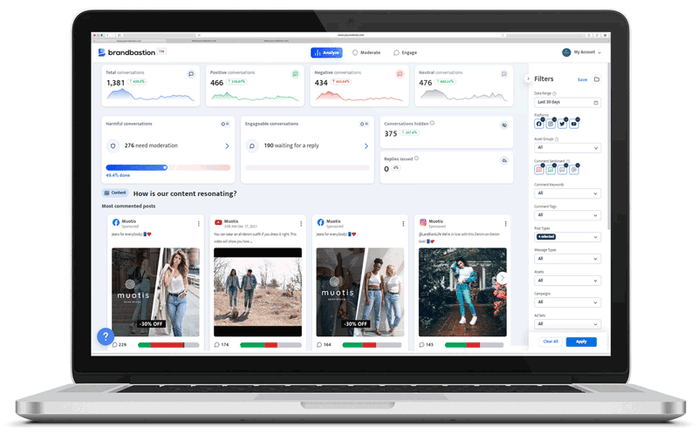
Conclusion
All in all, to be able to choose the best platform for your social media marketing, you need to understand your target audience, your marketing goal and budget, as well as the platform's potential and limitations. You do also need to consider the competition across platforms.
In addition, it's important to continually analyze and evaluate the performance of your social media marketing efforts. To do so, you could use a tool that provides valuable insights and data. BrandBastion offers the Lite Platform for businesses that would like to efficiently analyze, monitor, and manage social media conversations across platforms. Try our Lite Platform for free here!
BrandBastion | Case Studies | Design Rush
